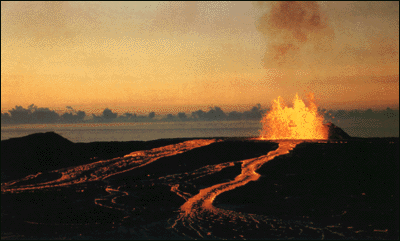
Robert I. Tilling
Christina Heliker, and
Thomas L. Wright

| Cover photograph: Lava cascades fed by fountains at vent (skyline) fall more than 75 feet to fill Aloi Crater during the 1969-71 Mauna Ulu eruption of Kilauea Volcano. (Photograph by Donald A. Swanson.)� | First Printing, 1987. Special thanks go to Taeko Jane Takahashi and J.D. Griggs, Hawaiian Volcano Observatory, for assistance with photography selection and to Martha Kiger for graphics design. | |
Preface 4 Introduction 5 Origin of the Hawaiian Islands
7 Hawaiian Eruptions in Recorded History 13 Volcano Monitoring and Research
16
Kilauea's Volcanic "Plumbing System" 24 Eruptive Style: Powerful but Usually Benign 26
Hawaiian Volcanic Products, Landforms, and Structures 37
Loihi: Hawaii's Newest Volcano 45 Volcanic Hazards and Benefits 47
Selected Readings 52 Selected Viewings 53 Endnotes 55
|
||